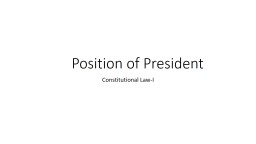

Constitutional LawI Position of President The President is the nominal executive or a Constitutional head He is the head of the nation but does not govern the nation Article 52 provides that there shall be a President of India ID: 1003175
Download Presentation The PPT/PDF document "Executive Position of President" is the property of its rightful owner. Permission is granted to download and print the materials on this web site for personal, non-commercial use only, and to display it on your personal computer provided you do not modify the materials and that you retain all copyright notices contained in the materials. By downloading content from our website, you accept the terms of this agreement.
1. Executive Position of PresidentConstitutional Law-I
2. Position of PresidentThe President is the nominal executive or a Constitutional headHe is the head of the nation, but does not govern the nationArticle 52 provides that there shall be a President of IndiaArticle 53 provides that all the executive power of the Union shall be vested in the President and he is the supreme power of all the defense services in Indian
3. Position of President before 1976Article 74(1)- There shall be Council of Minister with PM at its head to aid and advice the President in exercise of his powerArticle 74(2)- The question whether any, and if so what, advice was tendered by Ministers to the President shall not be inquired into in any courtOriginally there was no constitutional provision making ministerial advice binding on presidentThe SC in number of cases discussed position of President
4. ….Position of President before 1976Ram Jawaya vs. State of Punjab(1955)- SC observed that our constitution has adopted British System of Parliamentary Executive President is only formal or constitutional head Real executive power is vested in Council of MinistersR.C. Cooper vs. UOI(1970)- SC observed that under constitution the President being constitutional head, normally acts in all matters including promulgation of an ordinance on the advice of his CoM
5. ….Position of President before 1976U.N.R.Rao vs. Indira Gandhi (1971)- SC observed that the conventions operating in Britain governing the relationship of Crown and Minister are very pertinent to the Indian Constitution as well, and formal provision of constitution should be read in light of those conventionCourt further observed that the Constituent Assembly did not choose the Presidential System of GovernmentSamsher Singh vs. State of Punjab(1974)- SC observed that whenever constitution requires satisfaction of President for exercise by him any of the power or functions, it is not his personal satisfaction but in constitutional sense it is satisfaction of CoM
6. ….Position of President before 1976UOI vs. Sripati Ranjan (1975)- Respondent dismissed from his service by Collector of Custom.He preferred an appeal to the President under Service RuleMinister of Finance rejected appeal without any reference to PresidentSC held that the appeal was validly disposed of by the MinisterAny reference to the President shall be to the CoM
7. Prime Minister VS President ControversiesSoon after Constitution coming in force, President Rajendra Prasad wrote letter to PM expressing desire to act solely on his own judgment independent of CoM in matters giving assent to Bill and sending messages to ParliamentPM Nehru consulted Attorney General Setalvad and Ayyar, Member of Drafting CommitteeBoth gave opinion that President has no discretion
8. Position of President after 1976Article 74 was amended by Constitution 42nd Amendment Act 1976It reads as under:(1)There shall be a Council of Ministers with the Prime Minister at the head to aid and advise the President who shall, in the exercise of his functions, act in accordance with such advice: Provided that the President may require the council of Ministers to reconsider such advice, either generally or otherwise, and the President shall act in accordance with the advice tendered after such reconsideration (Added by 44th Amendment Act 1978)
9. Position of President after 1976the “the aid and advise” is binding on the president but this is not absoluteThere can be various circumstances where the President has no obligation to follow his Council of MinistersEg. Dissolution of Lok Sabha, Appontment of PM
10. Impeachment of President: Article 61Article 61 provides for the Impeachment of the President of IndiaImpeachment is the process by which either House of Parliament levels charges against a Constitutional authorityPresident can be impeached from his Office only for the violation of the ConstitutionWhat constitute ‘violation of the Constitution’ is a matter to be decided by House which tries the chargeImpeachment is brought from USArt.II, Section 4 of US Constitution states that the President can be removed on grounds of treason, bribery, high crimes or misdemeanour
11. Procedure for impeachment of the PresidentWhen a President is to be impeached for violation of the Constitution, the charge shall be preferred by either House of ParliamentNo such charge shall be preferred unlessthe proposal to prefer such charge is contained in a resolution which has been moved after at least fourteen days notice in writing signed by not less than one fourth of the total number of members of the House has been given of their intention to move the resolution, andsuch resolution has been passed by a majority of not less than two thirds of the total membership of the House
12. Procedure for impeachment of the PresidentWhen a charge has been so preferred by either House of Parliament, the other House shall investigate the charge or cause the charge to be investigated and the President shall have the right to appear and to be represented as such investigationIf as a result of the investigation a resolution is passed by a majority of not less than two thirds of the total membership of the House by which the charge was investigated or cause to be investigated, declaring that the charge preferred against the President has been sustained, such resolution shall have the effect of removing the President from his office as from the date on which the resolution is so passed
13. THANK YOU